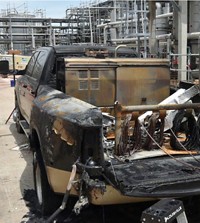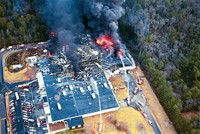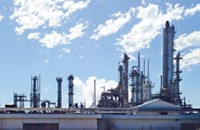Advertisement
Grab your lab coat. Let's get started
Welcome!
Welcome!
Create an account below to get 6 C&EN articles per month, receive newsletters and more - all free.
It seems this is your first time logging in online. Please enter the following information to continue.
As an ACS member you automatically get access to this site. All we need is few more details to create your reading experience.
Not you? Sign in with a different account.
Not you? Sign in with a different account.
ERROR 1
ERROR 1
ERROR 2
ERROR 2
ERROR 2
ERROR 2
ERROR 2
Password and Confirm password must match.
If you have an ACS member number, please enter it here so we can link this account to your membership. (optional)
ERROR 2
ACS values your privacy. By submitting your information, you are gaining access to C&EN and subscribing to our weekly newsletter. We use the information you provide to make your reading experience better, and we will never sell your data to third party members.
Safety
Safety Board Backlog Remains
Chemical safety board chairman lays out plans, stakeholders offer strong support and concerns
by Jeff Johnson
January 2, 2012
| A version of this story appeared in
Volume 90, Issue 1

In 2011, the Chemical Safety & Hazard Investigation Board (CSB) closed five investigations, issued a handful of major accident investigation reports, produced several safety videos, conducted its first national webinar, and began three new investigations. It was a successful year, says CSB Chairman Rafael Moure-Eraso, who sat down with C&EN for an end-of-year interview.
Moure-Eraso, a former professor in the School of Health & Environment at the University of Massachusetts, Lowell, has led the board since the summer of 2010. The board is charged with finding the root cause of chemical accidents and has no authority to issue fines or violations. Moure-Eraso is upbeat and gregarious as he describes CSB’s accomplishments during 2011 in encouraging what he calls a “culture of safety” when Americans handle chemicals.
He singles out an influential CSB report on a Connecticut power plant construction accident that occurred when natural gas was used to purge debris from gas pipelines; an explosion resulted, and seven workers died. CSB’s report and safety video led the state to pass legislation last year banning the practice. The issue is particularly important, Moure-Eraso says, because some 150 natural gas power plants are under construction in the U.S. Five are in Connecticut.
The CSB chairman also points to the board’s report last year of its first investigation of a university laboratory accident. The 2010 accident occurred in a chemistry department lab at Texas Tech University and critically injured a student researcher. The investigation was widely followed by the academic community and resulted in an influential report as well as CSB’s first webinar, which drew more than 400 viewers and helped drive safety changes at academic laboratories.
Academic lab safety is of high interest to Moure-Eraso, he says, because of his 22-year career as a university health and environment professor and department chairman.
“We benefited greatly from being the subject of CSB’s investigation,” says Taylor Eighmy, Texas Tech vice president for research. “We are working hard to change the culture here, and we fully embrace the view that laboratory safety is as important to faculty member scholarship as is science.”
Eighmy called CSB’s recommendations “elegant in nature” as they forced the university to look “with a new lens” at how they manage lab risk.
Similarly, the board earns kudos from other stakeholders, both the chemical industry and unions. But longtime board watchers have a major concern, and it’s something that has vexed the board since it was established under the 1990 Clean Air Act.
That top concern is CSB’s ability to keep up with the flow of chemically related accidents that come its way with disturbing regularity. Feeding this worry is the board’s anemic funding; CSB’s budget and staff level stayed pretty much flat for more than a half-dozen years. In 2012, the appropriation is set to hit $11.13 million, up from $10.60 million in 2010. The staffing has also remained at about 39 employees, including investigators, lawyers, technical experts, and others who also support the board’s four members and its chair.
“Essentially, its budget is pocket change,” says Michael L. Wright, director of health, safety, and environment for the United Steelworkers, which represents chemical and refinery workers. “Look at the cost of one chemical accident—preventing it far outweighs any CSB budget increase.”
Wright also worries about the number of ongoing, uncompleted investigations. That backlog has also stayed flat over the past few years, and today there are 16 outstanding investigations. Of those, two involve accidents stretching back to 2008, and five occurred in 2009.
The board is well aware of the delay and is also concerned, Moure-Eraso says. In mid-January, he says, CSB members and staff will meet to prioritize these investigations to address the backlog and establish a timeline to clean them up.
The sooner, the better for Wright.
“We’d like the board to get some of those investigations cleared up quickly,” he says, “because sadly there will be more chemical accidents, and CSB needs to be able to have resources to investigate those.”
The Society of Chemical Manufacturers & Affiliates (SOCMA), an industry trade organization, also worries about CSB’s budget. “There is no denying that financial and resource constraints limit the board’s ability to undertake any major new investigations, should they become necessary, which should concern industry and government,” says William E. Allmond IV, SOCMA vice president of government relations. “However, despite constraints, SOCMA has confidence that CSB will be able to carry out its statutory obligations.”
Moure-Eraso estimates that each year in the U.S. some 200 accidents occur that meet CSB criteria to merit an investigation. In 2010, CSB data show, some 32 chemical accidents took place where at least one worker was killed, yet CSB was unable to deploy investigators to the accident sites.
This “investigative gap” was criticized in a 2008 Government Accountability Office report. In response, CSB has pursued various options other than lengthy investigations and full reports. These include, for instance, shorter case studies, three-page safety bulletins, and videos. “We have to be agile,” Moure-Eraso says, and use a range of options to communicate what the board has learned.
The quality of CSB investigations, however, has been “outstanding,” Wright says. Despite the gap, he says, “if there is a trade-off between thoroughness and timeliness, it should be resolved in favor of thoroughness.”
Wright also says CSB presentations of its report recommendations—videos and its website—are “a model of how to get information to stakeholders.”
Among top priorities for 2012, Moure-Eraso says, CSB hopes to complete its investigation of the oil refinery accident at the Tesoro refinery in Anacortes, Wash., which killed seven workers in April 2010, and of the BP/Transocean Deepwater Horizon oil rig blowout in the Gulf of Mexico that killed 11 workers also in April 2010.
CSB’s investigation of Tesoro can provide many lessons for refineries, Moure-Eraso says, noting that six of CSB’s ongoing investigations are of refinery accidents. The equipment that blew up at Tesoro was 38 years old and typical for this mature industry with a history of accidents.
The Deepwater rig investigation has been a thorny one for CSB. It has drawn as many as a dozen CSB investigators at various times, Moure-Eraso notes, adding that Congress urged CSB to take up the oil rig disaster and CSB held out the hope of additional funding that never materialized. The board’s investigation is expected to cost $2.5 million and be completed this year.
One reason for the delay in wrapping up this report is that CSB has been stymied by Transocean, the drilling rig owner and operator, which has refused to respond to subpoenas to turn over key information to CSB, Moure-Eraso says. The board has turned to Justice Department subpoenas to kick loose documents.
Although more than a half-dozen other investigations of the Deepwater accident are complete, Moure-Eraso says the board’s report will be valuable. CSB, he says, will concentrate specifically on worker actions and actual rig operations. So far, its investigation has found that rigs rely on manual safety controls to a surprising degree, much more than in onshore chemical facilities, and its report will explore shifting to automated systems as well as developing new process safety management indicators for offshore rigs, similar to those in onshore chemical plants.
Also this year, CSB will develop a five-year strategic plan and regain its full complement of five board members, two of whom retired last year.





Join the conversation
Contact the reporter
Submit a Letter to the Editor for publication
Engage with us on Twitter